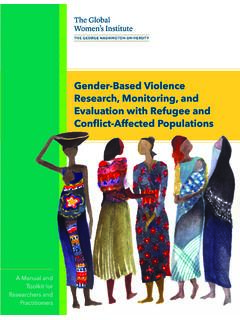Transcription of MONITORING AND EVALUATION MANUAL - Enterprise …
1 MONITORING AND EVALUATION MANUAL Written for the SDC project the Mercy Corps implemented Alliances Lesser Caucasus Programme and adapted from the Alliances Kvemo Kartli MONITORING and EVALUATION MANUAL by Helen Bradbury & Zakaria Tavberidze Marneuli 2015 Page | 2 The Alliances Lesser Caucasus Programme (ALCP) is a Swiss Agency for Development and Cooperation market development project implemented by Mercy Corps Georgia working in the dairy, beef, sheep and honey sub-sectors in the Kvemo Kartli (KK), Samtskhe Javakheti (SJ) and Ajara (AJ) regions in Southern Georgia, regions all highly dependent on livestock production. The programme has been audited according to the Donor Committee for Enterprise Development (DCED) Standard and is committed to the successful implementation and measuring of Women s Economic Empowerment.
2 project Time Frame: The ALCP began on March 1st 2014 and is set to run until February 28th 2019, incorporating a second phase of Alliances Kvemo Kartli of three years implementation and two years standby, of four years implementation and one year standby in Ajara and from January 1st 2015 a two year standby phase for the former Alliances SJ, which will have completed six years of inception and implementation in December 2014. Our Partners: The programme works in partnership with the International Association of Agricultural Development (IAAD) and has scope to contract locally grounded technical expertise through sub contracts for Gender, Governance and DRR. The Goal of the ALCP is to contribute to poverty alleviation and the transition to a durable market economy for the livestock sector in the selected regions of KK, SJ and AJ, by creating sustainable changes in the dairy, beef, sheep and honey market systems for the ultimate equitable benefit of small, poor farmers, regardless of gender or ethnicity.
3 The programme is run according to the M4P (Making Markets Work for the Poor Approach) a market systems development approach which facilitates key market players in the relevant value chains to address key constraints in core markets and supporting functions to exploit pro poor opportunities for growth. Sustainability is built in through a minimum co-investment of 35% from the market players with whom it invests. Targets: The previous phases of the Alliances programme have considerably exceeded their targets, impact which is now being bolstered by the appearance of crowding in. The ALCP Target is to reach 24,000 households which is 20% of poor households in the programme area, who will benefit directly and indirectly through improved services, markets and operating environment, with increased income from sales, reduced production & transaction costs, increased net worth and employment.
4 90% of Alliances-KK supported business will still be operating without programme support by the end of the programme and 49,000 (41%) households will have improved awareness of local Disaster Risk Reduction (DRR) directly related to livestock production. For more information please go to: Suggested Citation: Bradbury H & Tavberidze, Z (2015) Alliances Lesser Caucasus Programme MONITORING and EVALUATION MANUAL . Alliances Lesser Caucasus Programme. Mercy Corps, Georgia. Page | 3 ABBREVIATIONS AJ: Ajara AF: Application Form BDO s: Business Development Officers: BDS Business Development Services CPC Cheese Producing Centre DRR Disaster Risk Reduction FS&H Food Safety and Hygiene GEL Georgian Lira (currency) GOI: Gender Overt Intervention GSI s: Gender Sensitized Interventions IP: Investment Plan ISF Investment Support Facility KK Kvemo Kartli MAP: MONITORING Action Plan Bi-monthly MAP meeting: MONITORING Action Plan Meeting: M&E: MONITORING and EVALUATION M4P: Make Markets Work for the Poor Approach MC: Mercy Corps MCC: Milk Collection Centre RC s: Results Chains IRC s: Intervention Level Results Chains OMC: Outcome MONITORING Concept ORC s.
5 Outcome Level Results Chains SDC: Swiss Agency for Development and Cooperation Page | 4 GLOSSARY1 Activity: A discrete piece of work, typically represented by a contract between the programme and a contractor, partner or consultant. Interventions typically consist of several activities that are intended to achieve change at various different points in the overall market system. Aggregate: To combine the impact a programme has caused from various interventions; overlap must be taken into account when aggregating impact. Assess: To gauge the change in an indicator using quantitative and/or qualitative methodologies. Assumption: A supposition or best guess which forms part of the basis for calculation of an indicator value.
6 Attribution: The ascription of a causal link between observed (or expected to be observed) changes and a specific intervention. Baseline: An analysis describing the situation prior to a development intervention, against which progress can be assessed or comparisons made. The status of indicators before an intervention starts or has been influenced by intervention activities against which it can be measured later again to see intervention impact. Calculate: To compute the value of an indicator based on several different pieces of information. Copying: Other target enterprises/ farmers copying behavioural changes that those affected directly by programme activities have adopted. Crowding in: Enterprises at levels other than the target level copying behaviours that those affected by programme activities have adopted or entering a sector or value chain as a result of improved incentives and environment created (at least partly) by the programme.
7 This term also applies to government agencies or civil society organizations, who are not directly involved in the programme, copying behaviours of those who are directly involved in the programme, or who change their behaviour as a result of improved incentives or environment created (at least partly) by the programme. DCED Standard for Measuring Results in PSD, Version VI, January 2013 Counterfactual: Pervasive factors with specific relevance to the agricultural sector in the operating environment which can have positive or negative effects and which must be considered when separating programme effects from what would have happened anyway (attribution). Such as: economic conditions including the rate of inflation, rate of interest, lending, new laws implemented ( food safety and hygiene, export and import), other projects and donor activities in sector and/or area Direct impact: Changes that are caused as a result of programme interventions on service providers with which the programme has had significant contact and target beneficiaries.
8 Direct impact does not include the results of systemic changes such as copying or crowding in. 1 Taken and adapted from the DCED Standard Version VI January 2013 Page | 5 Displacement: Some enterprises may be negatively affected because others are benefiting from programme activities. Displacement is the amount of negative effect on those enterprises harmed by programme activities. Donor Committee for Enterprise Development (DCED): With 22 members comprised of bi- and multilateral donors and agencies as well as private foundations the committee has a vision of making PSD more effective. It has three strategic priorities; sharing knowledge and experience between donors, development agencies and field programmes; developing and disseminating knowledge and guidance on good practice in PSD; and communicating evidence on results in PSD.
9 The DCED developed and maintains the DCED standard for Results Measurement a set of must and recommended guidelines against which PSD and market development programmes may be audited for results measurement systems in place or in use , by DCED consultants. The audit has become an influential global benchmark of MONITORING and measurement quality in PSD and market development programmes. Estimate: An approximation of the value of an indicator or of attribution based on information gathered. Impact: Positive and negative, primary and secondary long-term effects produced by a development intervention, directly or indirectly, intended or unintended. Impact Assessment: The process of estimating a programme s impact on enterprises, poverty reduction and/or other development goals.
10 Indirect impact: Changes caused, at least partly, by programme activities which cannot be linked in a direct line to organizations or enterprises with which the programme has had significant contact. Indirect impact includes the results of systemic changes such as copying and crowding in and second order changes resulting from a programme s direct or indirect impact, for example changes in non-targeted sectors or changes in local economies resulting from the increased purchasing power of a programme s target beneficiaries. Indicators: Quantitative or qualitative factor or variable that provides a simple and reliable means to measure achievement, to reflect the changes connected to an intervention, or to help assess the performance of a development sector.















